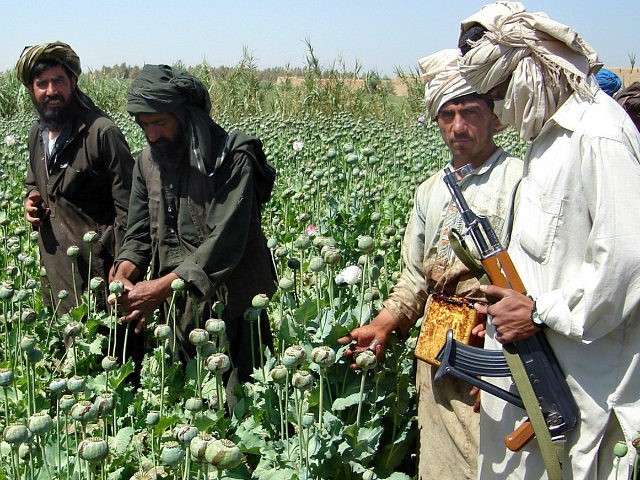The unprecedented U.S.-led air campaign against the Taliban’s economic engine, opium and heroin, has destroyed 73 drug labs and deprived the narco-jihadist group of $42 million in proceeds since President Donald Trump authorized the operations in November.
“It’s the first time we’ve used air power to … strike and put pressure on Taliban revenue in the 17 years of the war,” U.S. Air Force Brig. Gen. Lance Bunch, the chief of air operations targeting insurgent revenues, told USA Today, referring to the authority granted by President Trump last year.
“The new authority allowed us to strike in areas where previously the Taliban felt like they were completely safe,” added the general.
Referring to the air campaign, USA Today notes:
It also minimizes the impact that corruption had on previous efforts to target drug operations. For example, police or Afghan army officials could be bribed to delay or abort a drug raid. Airstrikes are centrally controlled, and decisions are largely independent of local officials.
President Trump’s decision to expand the U.S. air campaign to target the Taliban’s drug activities came amid the historic production of opium, the main ingredient in heroin.
Following a dramatic drop in counternarcotics activity authorized by former President Barack Obama, the cultivation area and overall production of opium skyrocketed, providing the Taliban with more funding to continue waging its terror campaign as the U.S. troops withdrew from Afghanistan.
The dramatic increase in opium cultivation coincided with a Taliban resurgence.
According to the U.S. government, the Taliban generates at least 65 percent of its funding, estimated at $300 million to $500 million annually, from the production and smuggling of opium and heroin.
“The Taliban gets between $300 million and $500 million a year as their total budget,” Gen. Bunch told reporters in December 2017. “Sixty-percent of that, or almost $200 million, comes from the narco-processing trade.”
Although opium generates most of its narcotics-linked funding, Taliban terrorists are also reportedly involved in trafficking other illicit drugs.
USA Today acknowledges:
Officials say it is still too early to measure the impact of the strikes on the Taliban’s operations. The Taliban generally reduces its combat operations during the winter months when many areas remain impassable. A new fighting season is just getting underway.
The air campaign won’t eliminate the massive drug trade in Afghanistan but is designed to have an impact on Taliban operations as they gear up for another fighting season, said David Sedney, a senior associate at the Center for Strategic and International Studies and former top Pentagon official.
The U.S. Special Inspector General for Afghanistan Reconstruction (SIGAR), a watchdog agency, has questioned the effectiveness of the air campaign, noting that the costs may outweigh the outcome.
Citing the U.S. Drug Enforcement Administration (DEA), SIGAR estimated early this year that are “as many as 400–500 active [drug production] facilities [in Afghanistan at any given time.”
Reuters learned from unnamed Afghans familiar with the drug industry in their country that “it would only take three or four days to replace a lab, which generally has a low sunk-cost.”
SIGAR noted that, by contrast, it costs tens of thousands of dollars per hour to operate the aircraft used to carry the anti-opium operations.
The opium trade is worth about $3 billion, estimated the watchdog agency.
In 2014, it reported:
While occupying less than 3% of land under cultivation, opium is Afghanistan’s most valuable cash crop, and opiates — opium, morphine, and heroin — are its largest export, with an estimated value of $3 billion at border prices.
Furthermore, the opium economy directly provides up to 411,000 full-time-equivalent jobs — more than the entire Afghan National Security Forces (ANSF) — and supports additional secondary-effect jobs in the licit economy.
Despite more than $8.5 billion in American taxpayer funds devoted to counternarcotics activity in Afghanistan, the country remains the world’s top supplier of opium and heroin.
Although the DEA asserts that only a small portion of Afghan heroin makes it onto American soil, some U.S. officials have questioned whether the production of the drug in Afghanistan is fueling the unprecedented heroin overdose crisis gripping America.
Under President Trump, the U.S. military has intensified its overall air operations in Afghanistan.
Munitions dropped on terrorists in Afghanistan under Trump (about 5,208) have exceeded those launched during the three years preceding his inauguration (2014, 2015, 2016) combined, U.S. Central Command (CENTCOM) data shows.
In February 2018 alone, the U.S. military launched 469 airstrikes, a record high since 2012 — second only to the 653 dropped in October of last year.

COMMENTS
Please let us know if you're having issues with commenting.